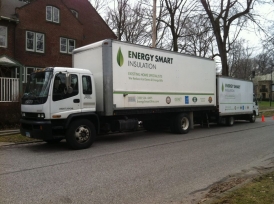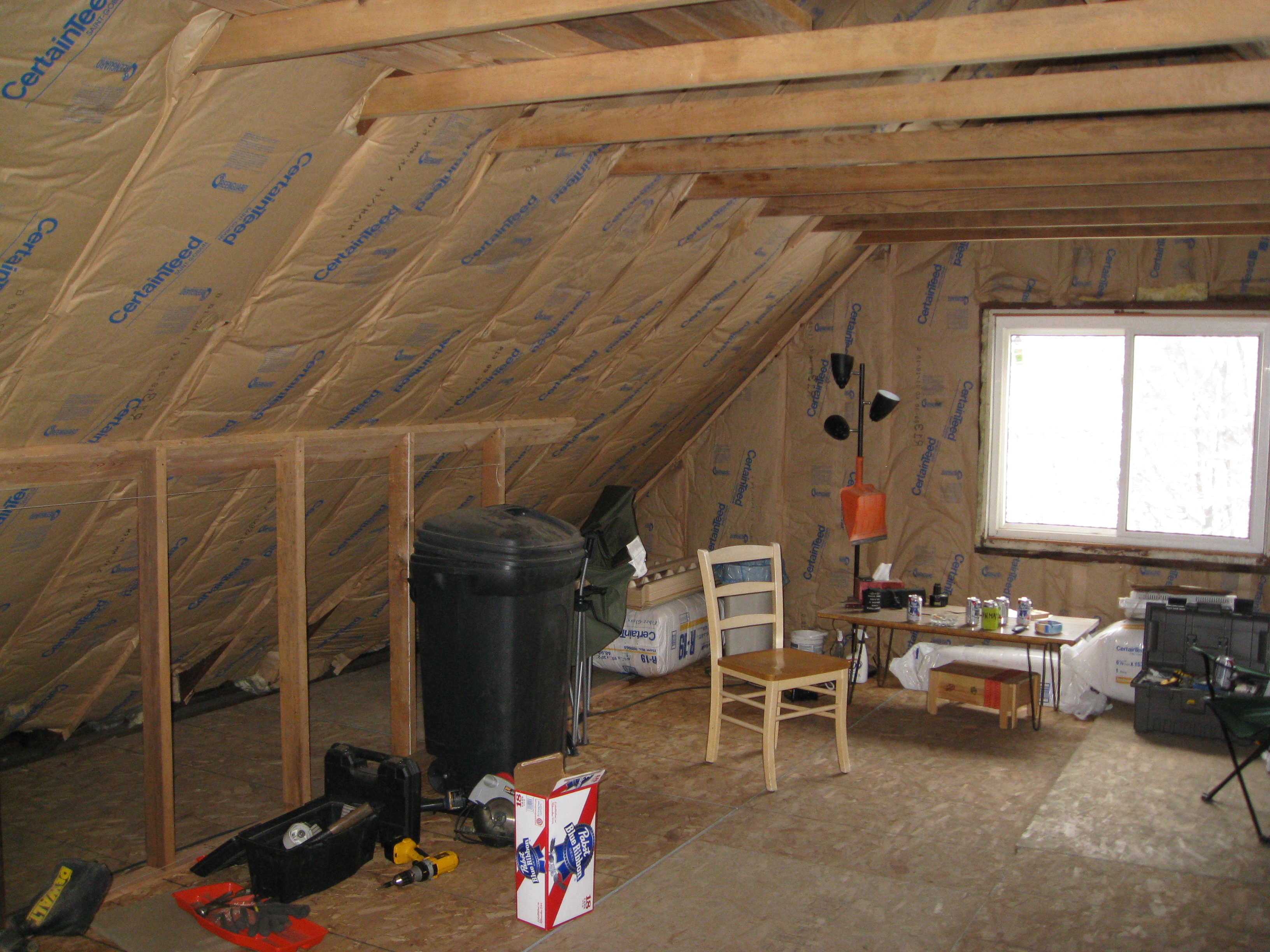A Tale of 2 Houses: Low Hanging Fruit is Poisoned
Above: The Cape Cod 47% Savings
Above: The Dutch Colonial 9% Savings
Have you ever fallen short in life? We just figured out that we did. We also confirmed that Low Hanging Fruit is poisoned, it leads to disappointment.
Is 9% savings ok? Or would you rather have 47% savings? The difference between these two houses is small, but not the results. This is a tale of 2 houses, a Cape Cod and a Dutch Colonial.
With our previous process, we didn’t often get client utility bills to compare before and after a job, but we just looked at 2 similar houses & similar jobs with shockingly different results for one that we did get. This is another radically transparent post where we out our own failures.
First, a few definitions.
Half Story Homes – Homes with a finished attic. A 1.5 story home is often known as a Cape Cod or a bungalow. The first home is a Cape Cod. A 2.5 story home is the same only with 2 stories beneath the finished attic. The second home is a 2.5 story Dutch Colonial, which looks rather like a barn.
Heating Degree Day (HDD) – A way to measure how cold a year was to help make one year comparable to another. The base temperature is usually 65 degrees, so if there is a 25 degree day on average, that is a 40 Heating Degree Day day. (65-25 = 40) If you add up all the heating degree days in a season, you get an idea of how cold that climate is. Cleveland is pretty cold, our winters run in the 6000 HDD range. Atlanta GA is around 2700; Miami a paltry 200, they have lots of Cooling Degree Days.
Caveat: The Cape Cod is preliminary data, only 1 month – November 2013 vs. November 2014. The months and bills are remarkably similar, so it’s not a really risky comparison. We will be watching the home over the winter to see if this conclusion holds up.
The Dutch Colonial was done with our old process and was an attic only job using almost exclusively cellulose. We were chasing a $1250 rebate from the gas company.
The Cape Cod got the roof deck spray foamed in the knee wall attics (the little triangular ones), cellulose in the top attic, the front wall and a garage wall insulated, and a crawlspace encapsulated – which means we covered the floor with plastic and spray foamed the walls and rim joist. We were trying to prevent a fast temp drop during winter, make the home more comfortable, bring the second floor into temperature balance with the first, and reduce noise from the master to the guest bedroom.
Here’s a comparison of the 2 homes. If you hate numbers, pretend the next section doesn’t exist and simply know that these jobs were surprisingly similar to have such different results.
Similarities
| Cape Cod | Dutch Colonial | |
| Stories | 1.5 | 2.5 |
| Square Footage | 2400 | 2032 |
| Test In Air Leakage cfm501 | 5800 | 5800 |
| Test Out Air Leakage cfm501 | 3100 | 3600 |
| Air Leakage Reduction | 46.5% | 37.9% |
| Work Scope: Attic | Yes | Yes |
| Annual Gas Usage Before mcf | 154.9 | 128.6 |
| Usage Reduction/HDD2 | 47% | 9% |
| Usage Reduction mcf2 | 47.5% | 2.5% INCREASE3 |
Differences
| Cape Cod | Dutch Colonial | |
| Year Built | 1956 | 1915 |
| Test In Leakage/sq. ft. | 2.41 | 2.85 |
| Test Out Leakage/sq. ft. | 1.29 | 1.77 |
| Work Scope: Crawlspace | Yes | No |
| Work Scope Wall Insulation | Yes (300 sq. ft.) | No |
| Top Plates Sealed | Yes | No |
| Insulation Type | Spray Foam/Cellulose | Cellulose |
| Attic Insulation Placement | Roof Deck/Attic Floor on Top | Knee Walls/Attic Floor |
| Efficient Furnace | Yes | No |
| Right Sized Furnace5 | Yes | No |
| Got to Tipping Point | Yes | No |
| Project Cost | $17,000 | $6,000 |
Low Hanging Fruit Is Poisoned
We believe every home has a tipping point. If you get far enough, amazing things start to happen. Fall short, and totally miss the mark. In energy efficiency ‘low hanging fruit’ really doesn’t exist. Typical thinking would suggest that making a few improvements delivers substantial gains. That might look something like this:
Our experience tells us results are often disappointing from this way of thinking, it requires going further to see remarkable results. All of a sudden good things start happening fast until benefits begin to taper off:
Put those two together, and you see the first gap where low hanging fruit doesn’t deliver, a ‘Gulf of Disappointment’, then go far enough to get remarkable results in the second gap, the ‘Sea of Satisfaction.’ Yes, they’re cheesy. Deal with it.
The Dutch Colonial went fairly far it was a serious attic job, so it’s probably analagous to 2.5 investments for 1 benefit. A little further and things will start happening. The bad part is, Low Hanging Fruit Thinking would suggest those 2.5 investments would deliver 4.5 benefits. Yet only 9% savings arrived. That is the result of chasing as far as the $1250 rebate would get us, and stopping.
The Cape Cod got over the tipping point but still has further to go, so it’s like 4 investments for 6 benefits. 47% savings arrived. The client objectives were also met, with the exception that the master bedroom is still a little cool.
We believe that a very large reason that residential energy efficiency has not taken off is that projects just don’t go far enough to get real results. This just confirms the homeowner suspicion that contractors are only out to get their money. Thankfully I know Steve pretty well, the 9% Dutch Colonial guy, and I doubt he’ll be that angry, he’s likely to take another step and push his home into remarkable territory.
What Really Made the Difference?
To be completely honest, we really just aren’t sure. It’s clear we didn’t go quite far enough yet. There were no real objectives on the Dutch Colonial job aside from using the rebates effectively and hopefully saving energy. Having objectives helps focus a project rather than chasing rebates and stopping. A few big things come to mind, though:
1. Leakage/square foot remained quite a bit higher on the Dutch Colonial. We’ve found the closer you get to 1 unit of leakage/square foot, or under, the better.
2. The Dutch Colonial has 2 full exposed stories vs. 1 on the Cape Cod. Although the air leakage in walls as not as important as leakage in the attic due to stack effect, it’s still a lot of exposed area that is not insulated or air sealed.
3. The Dutch Colonial didn’t have the top plates of the second story sealed.4 Top plates are the top of any wall, and while they are often a very small part of the leakage in a home, because they are at the top, they are very important.
4. The Dutch Colonial retained it’s oversized, single speed, low efficiency furnace, kind of like a V-8 crammed into a Prius, it just isn’t a good match. Check out this video of how an oversized furnace can lead to comfort problems and high energy use.
5. The Dutch Colonial isn’t as comfortable, so the thermostat gets played with more. This one we can’t really prove, because we don’t have any way of tracking it. We use Ecobee thermostats to track equipment run time and thermostat set points. In our experience, more comfortable people don’t play with the thermostat, and consequently temperatures stay more even and comfortable while using less energy. Hence comfort is a very high priority for us. Check out our Ecobee datalogging gallery to learn more.
6. Prescriptive Improvements – A little love goes a long way. Spending more time on diagnosis leads to better understanding and better results than rushed ‘take two of these and call me in the morning’ thinking. The Cape Cod client went through our full process, and LOVED it, check out our Google reviews, it’s the fourth one down, Adam wrote it. For the Dutch Colonial, we didn’t ask a lot of questions, we just did what we thought was best without finding out what the homeowner was trying to solve.
7. It just wasn’t far enough. One more major measure may make a surprising difference. Air sealing the basement and insulating the above grade walls may be enough. A new, right-sized furnace may be enough. It’s tough to tell without doing some math, which requires an energy model, which requires an energy audit first. An energy model gives insight how various measures will impact performance and helps make decisions easier to see and understand by bringing clarity to complex challenges.
Some Results DID Show Up
It should also be mentioned that in talking to the Dutch Colonial owner, he has noticed that the house was substantially less drafty last winter. He was also surprised how cool the house stayed in the summer vs. before since he doesn’t have air conditioning. The attic insulation and air sealing helped keep the summer heat out of the house. There were fairly substantial comfort gains, if not energy savings. Energy savings do not equal comfort improvements and vice versa, we’ve found that at first some comfort gains are made, but in time both energy savings and comfort gains arrive. That is for another article.
The End?
Hopefully the Dutch Colonial owner hasn’t lost his faith in Home Performance and will sign up for a little more work. Doing the math last week, the difference between 9% and 47% was stunning, and sobering. It also backed up the hypothesis that low hanging fruit is poisoned, so deeper measures need to be taken.
Time for the Pitch
Do you want remarkable results? It begins with planning, not contracting work. Asking lots of questions helps inform where the tipping point for your home may be. So does running an air leakage test with a blower door. If we don’t set a low enough target, results may not show up.
How do you set a target? Diagnosis. Measurement. Planning. Which is precisely what our Comprehensive Planning Process does. It all begins with an inexpensive consultation to be sure we are a good fit for each other.
Sound intriguing? Good, but we have homework for you first. We require that clients have a basic understanding of building science before we arrive to help shorten the learning curve. Spend some time reading more on the site, suggestions are below. Then, once you are sure we are the company for you, fill out our questionnaire to get a discount on an initial consultation.
Further Reading
The Science Behind What We Do – Home Performance is rooted in science. Everything is interconnected, and we try hard to keep those connections in mind. Here’s the basics.
Problems We Can Help With – Want to know if we can help? Here’s a starter list.
Humidity: Another Make or Break for Your Home – A top 10 list of how high and low humidity screws things up in your home. Mold and flu and eczema, oh my!
Warning: Really Geeky Footnotes. Seriously. Really Geeky.
1 Blower doors, which are a big fan put in a door to measure air leakage, have a unit of cfm50 or cubic feet per minute at 50 pascals. A Pascal is a really, really small unit of pressure known as a ‘mouse fart’ in industry parlance. You are sitting right now in about 14.7 psi of pressure, that’s atmospheric pressure, and there are about 101,000 pascals in those 14.7 pounds per square inch. So 50 ain’t much. It’s like a 15 mph wind against all sides of your home simultaneously.
2 These numbers aren’t totally fair. The 2.5 story home compares over a whole year, where the 1.5 story home is only comparing 1 month. It’s the data we have to work with, though, so here it is. 11/13 had 584 HDD, 11/14 had 638 HDD, close enough to make a fair comparison for this month. We’re not backing out baseline usage for water heating, cooking, drying, etc.
3 Again this number isn’t fair because there is a good sized difference between one winter and the next. When it gets really cold, usage tends to increase exponentially similar to how your car gets far worse mileage at 75 mph than it does at 55 mph. The job was done 4/9/13. The following winter was brutal, 6606 HDD, the one before was more typical at 5858 HDD.
4 Top plates are the board across the top of a wall. These are typically what the roof joists sit on in the attic.
5 We often joke that the odds of finding a right sized furnace are about the same as the odds of hitting a unicorn on your way to work. Thanks to Stewart Unsdorfer of Central Heating and Air who is the ONLY heating and cooling guy we know of that right sizes furnaces, the furnace in this home was close enough to right sized, even after upgrades, that it wasn’t a strong recommendation to change it. From tracking, it appears that the low stage, 40,000 btus, will be adequate to heat the home down to 5 degrees, which Cleveland stays above 99% of the time and is known as design temperature.
Get the HVAC Guide

It's free! Make buying a new furnace, air conditioner, or heat pump less stressful.










